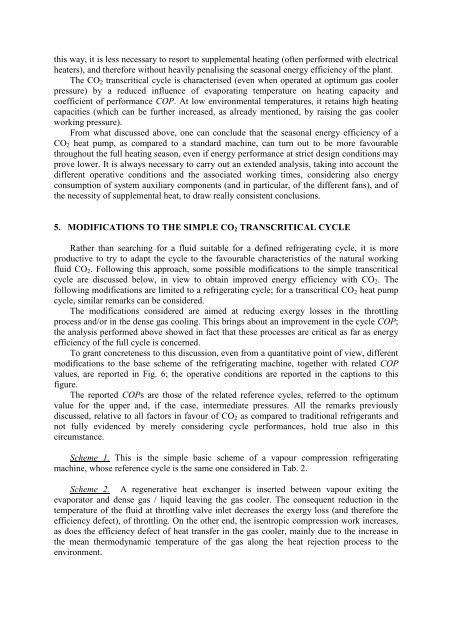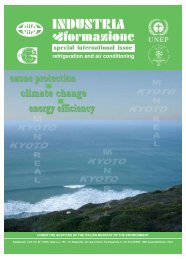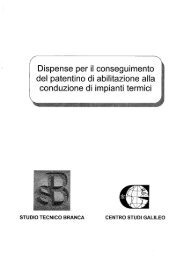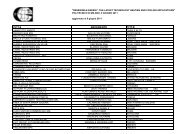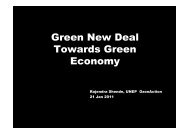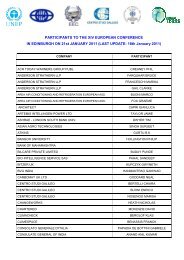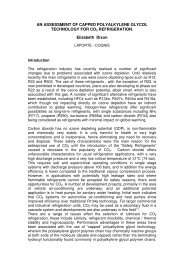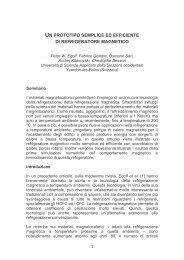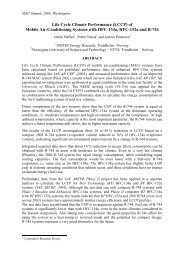PROPERTIES OF CO2 AS A REFRIGERANT - Centro Studi Galileo
PROPERTIES OF CO2 AS A REFRIGERANT - Centro Studi Galileo
PROPERTIES OF CO2 AS A REFRIGERANT - Centro Studi Galileo
You also want an ePaper? Increase the reach of your titles
YUMPU automatically turns print PDFs into web optimized ePapers that Google loves.
this way, it is less necessary to resort to supplemental heating (often performed with electrical<br />
heaters), and therefore without heavily penalising the seasonal energy efficiency of the plant.<br />
The CO 2 transcritical cycle is characterised (even when operated at optimum gas cooler<br />
pressure) by a reduced influence of evaporating temperature on heating capacity and<br />
coefficient of performance COP. At low environmental temperatures, it retains high heating<br />
capacities (which can be further increased, as already mentioned, by raising the gas cooler<br />
working pressure).<br />
From what discussed above, one can conclude that the seasonal energy efficiency of a<br />
CO 2 heat pump, as compared to a standard machine, can turn out to be more favourable<br />
throughout the full heating season, even if energy performance at strict design conditions may<br />
prove lower. It is always necessary to carry out an extended analysis, taking into account the<br />
different operative conditions and the associated working times, considering also energy<br />
consumption of system auxiliary components (and in particular, of the different fans), and of<br />
the necessity of supplemental heat, to draw really consistent conclusions.<br />
5. MODIFICATIONS TO THE SIMPLE CO 2 TRANSCRITICAL CYCLE<br />
Rather than searching for a fluid suitable for a defined refrigerating cycle, it is more<br />
productive to try to adapt the cycle to the favourable characteristics of the natural working<br />
fluid CO 2 . Following this approach, some possible modifications to the simple transcritical<br />
cycle are discussed below, in view to obtain improved energy efficiency with CO 2 . The<br />
following modifications are limited to a refrigerating cycle; for a transcritical CO 2 heat pump<br />
cycle, similar remarks can be considered.<br />
The modifications considered are aimed at reducing exergy losses in the throttling<br />
process and/or in the dense gas cooling. This brings about an improvement in the cycle COP;<br />
the analysis performed above showed in fact that these processes are critical as far as energy<br />
efficiency of the full cycle is concerned.<br />
To grant concreteness to this discussion, even from a quantitative point of view, different<br />
modifications to the base scheme of the refrigerating machine, together with related COP<br />
values, are reported in Fig. 6; the operative conditions are reported in the captions to this<br />
figure.<br />
The reported COPs are those of the related reference cycles, referred to the optimum<br />
value for the upper and, if the case, intermediate pressures. All the remarks previously<br />
discussed, relative to all factors in favour of CO 2 as compared to traditional refrigerants and<br />
not fully evidenced by merely considering cycle performances, hold true also in this<br />
circumstance.<br />
Scheme 1. This is the simple basic scheme of a vapour compression refrigerating<br />
machine, whose reference cycle is the same one considered in Tab. 2.<br />
Scheme 2. A regenerative heat exchanger is inserted between vapour exiting the<br />
evaporator and dense gas / liquid leaving the gas cooler. The consequent reduction in the<br />
temperature of the fluid at throttling valve inlet decreases the exergy loss (and therefore the<br />
efficiency defect), of throttling. On the other end, the isentropic compression work increases,<br />
as does the efficiency defect of heat transfer in the gas cooler, mainly due to the increase in<br />
the mean thermodynamic temperature of the gas along the heat rejection process to the<br />
environment.


